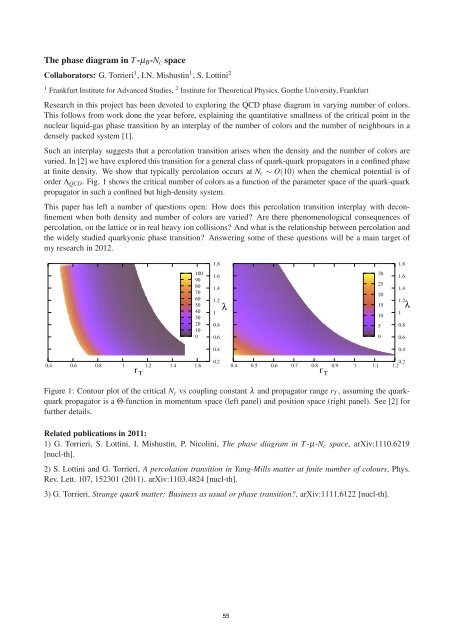FIAS Scientific Report 2011 - Frankfurt Institute for Advanced Studies ...
FIAS Scientific Report 2011 - Frankfurt Institute for Advanced Studies ...
FIAS Scientific Report 2011 - Frankfurt Institute for Advanced Studies ...
Create successful ePaper yourself
Turn your PDF publications into a flip-book with our unique Google optimized e-Paper software.
The phase diagram in T -µB-Nc space<br />
Collaborators: G. Torrieri 1 , I.N. Mishustin 1 , S. Lottini 2<br />
1 <strong>Frankfurt</strong> <strong>Institute</strong> <strong>for</strong> <strong>Advanced</strong> <strong>Studies</strong>, 2 <strong>Institute</strong> <strong>for</strong> Theoretical Physics, Goethe University, <strong>Frankfurt</strong><br />
Research in this project has been devoted to exploring the QCD phase diagram in varying number of colors.<br />
This follows from work done the year be<strong>for</strong>e, explaining the quantitative smallness of the critical point in the<br />
nuclear liquid-gas phase transition by an interplay of the number of colors and the number of neighbours in a<br />
densely packed system [1].<br />
Such an interplay suggests that a percolation transition arises when the density and the number of colors are<br />
varied. In [2] we have explored this transition <strong>for</strong> a general class of quark-quark propagators in a confined phase<br />
at finite density. We show that typically percolation occurs at Nc∼ O(10) when the chemical potential is of<br />
order ΛQCD. Fig. 1 shows the critical number of colors as a function of the parameter space of the quark-quark<br />
propagator in such a confined but high-density system.<br />
This paper has left a number of questions open: How does this percolation transition interplay with deconfinement<br />
when both density and number of colors are varied? Are there phenomenological consequences of<br />
percolation, on the lattice or in real heavy ion collisions? And what is the relationship between percolation and<br />
the widely studied quarkyonic phase transition? Answering some of these questions will be a main target of<br />
my research in 2012.<br />
100<br />
90<br />
80<br />
70<br />
60<br />
50<br />
40<br />
30<br />
20<br />
10<br />
0<br />
0.4 0.6 0.8 1 1.2 1.4 1.6<br />
r T<br />
1.8<br />
1.6<br />
1.4<br />
1.2<br />
1<br />
0.8<br />
0.6<br />
0.4<br />
0.2<br />
λ<br />
0.4 0.5 0.6 0.7 0.8 0.9 1 1.1 1.2 0.2<br />
r T<br />
Figure 1: Contour plot of the critical Nc vs coupling constant λ and propagator range rT , assuming the quarkquark<br />
propagator is a Θ-function in momentum space (left panel) and position space (right panel). See [2] <strong>for</strong><br />
further details.<br />
Related publications in <strong>2011</strong>:<br />
1) G. Torrieri, S. Lottini, I. Mishustin, P. Nicolini, The phase diagram in T -µ-Nc space, arXiv:1110.6219<br />
[nucl-th].<br />
2) S. Lottini and G. Torrieri, A percolation transition in Yang-Mills matter at finite number of colours, Phys.<br />
Rev. Lett. 107, 152301 (<strong>2011</strong>). arXiv:1103.4824 [nucl-th].<br />
3) G. Torrieri, Strange quark matter: Business as usual or phase transition?, arXiv:1111.6122 [nucl-th].<br />
55<br />
30<br />
25<br />
20<br />
15<br />
10<br />
5<br />
0<br />
1.8<br />
1.6<br />
1.4<br />
1.2<br />
1<br />
0.8<br />
0.6<br />
0.4<br />
λ
















